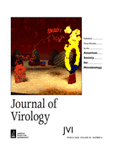An Animal Model That Mimics Human Herpesvirus 6B Pathogenesis
Date
2020Author
Wang, Bochao
Saito, Yasuyuki
Nishimura, Mitsuhiro
Ren, Zhenxiao
Tjan, Lidya Handayani
Iida-Norita, Rie
Tsukamoto, Ryuko
Komatsu, Masato
Itoh, Tomoo
Matozaki, Takashi
Moria, Yasuko
Metadata
Show full item recordAbstract
ABSTRACT Human herpesvirus 6B (HHV-6B), a T-lymphotropic virus, infects almost
exclusively humans. An animal model of HHV-6B has not been available. Here, we
report the first animal model to mimic HHV-6B pathogenesis; the model is based on
humanized mice in which human immune cells were engrafted and maintained. For
HHV-6B replication, adequate human T-cell activation (which becomes susceptible to
HHV-6B) is necessary in this murine model. Here, we found that an additional transfer of human mononuclear cells to humanized mice resulted in an explosive proliferation of human activated T cells, which could be representative of graft-versus-host
disease (GVHD) because the primary transfer of human cells was not sufficient to increase the number and ratio of human T cells. Mice infected with HHV-6B became
weak and/or died approximately 7 to 14 days later. Quantitative PCR analysis revealed that the spleen and lungs were the major sites of HHV-6B replication in this
model, and this was corroborated by the detection of viral proteins in these organs.
Histological analysis also revealed the presence of megakaryocytes, indicating HHV-6B
infection. Multiplex analysis of cytokines/chemokines in sera from the infected mice
showed secretions of human cytokines/chemokines as reported for both in vitro infection and clinical samples, indicating that the secreted cytokines could affect
pathogenesis. This is the first animal model showing HHV-6B pathogenesis, and it
will be useful for elucidating the pathogenicity of HHV-6B, which is related to GVHD
and idiopathic pneumonia syndrome.
IMPORTANCE Human herpesvirus 6B (HHV-6B) is a ubiquitous virus that establishes
lifelong latent infection only in humans, and the infection can reactivate, with severe
complications that cause major problems. A small-animal model of HHV-6B infection
has thus been desired for research regarding the pathogenicity of HHV-6B and the
development of antiviral agents. We generated humanized mice by transplantation
with human hematopoietic stem cells, and here, we modified the model by providing an additional transfer of human mononuclear cells, providing the proper conditions for efficient HHV-6B infection. This is the first humanized mouse model to
mimic HHV-6B pathogenesis, and it has great potential for research into the in vivo
pathogenesis of HHV-6B.

